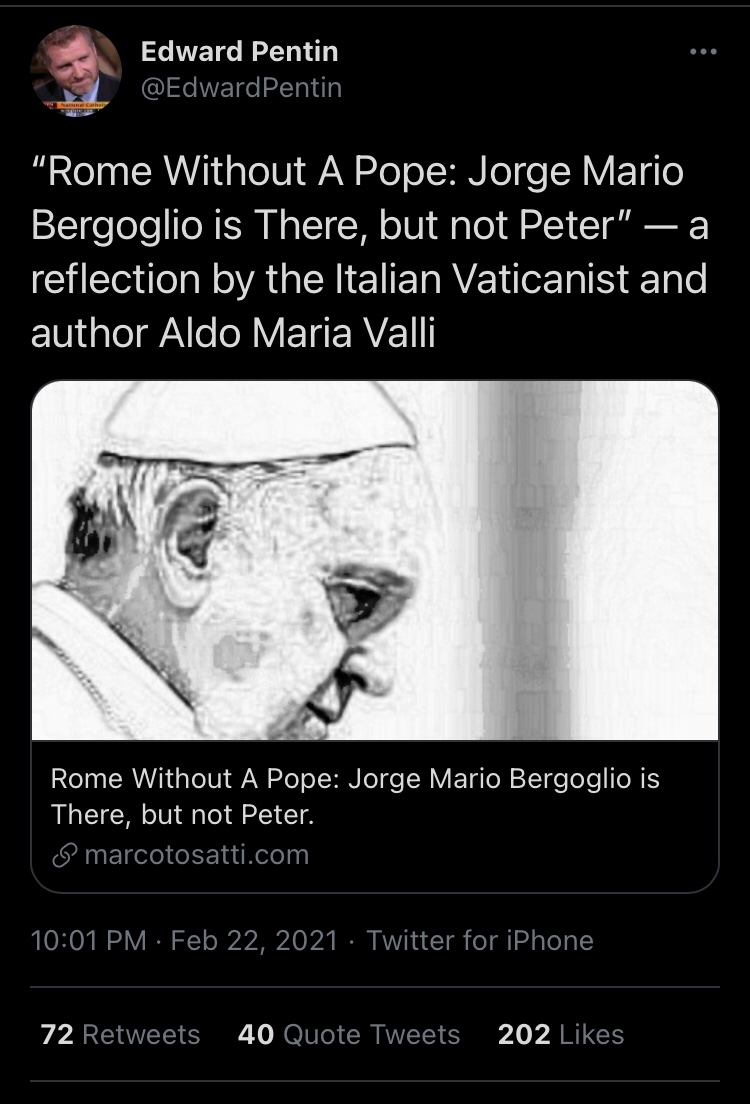Yesterday, 22 February, was the Feast of the Chair of St. Peter. Father Z. used the occasion to set out some interesting observations regarding the Petrine See, and how it began at Antioch (or one could even say Jerusalem). Emphasis mine:
“…Peter spent about 7 years in Antioch, guiding the church as its bishop, before he pulled up stakes, and… I guess… cathedra… and went to Rome. He wouldn’t have taken a literal chair, but he did take his office and authority, given to him by Christ. He had this office and authority before he went to Antioch, while he was at Antioch, when he left Antioch, when he got to Rome and when he died in Rome.
“Because the Petrine Ministry is necessary for the Church, Christ made it obviously a “hereditary” office, just as the Davidic stewards enjoyed with the conferral of keys. After Peter, another man held the Petrine Ministry and so on down to our day. That would have happened whether Peter had stayed in Jerusalem, stayed in Antioch, or had gone to Luoyang in China of the Han Dynasty.
“Based on Peter’s move from Antioch to Rome, there are those who say that there is nothing which absolutely connects being the Successor of Peter with being Bishop of Rome. He was, after all, The Rock, when he was in Antioch. For all practical purposes Petrine Ministry and office of Bishop of Rome now seem to be fused together. Most authors think they are inseparable. But… they weren’t, unless one thinks that Christ gave Peter His authority in view of Peter’s future in Rome. Possible, but there’s no Biblical evidence for that. On the surface, it looks like one could be Successor of Peter (who can be anywhere) and someone else Bishop of Rome (who should be in Rome).
“One supposes that, in time of need, some Successor of Peter could move his see to, say, Texas.” https://wdtprs.com/2021/02/wdtprs-22-feb-feast-of-the-cathedra-of-peter-2002mr-antioch-or-rome-or-somewhere-else/
Or, perhaps to the Vatican Gardens remaining with us always in the enclosure of St. Peter?
The idea that Pope Benedict may have split the Romanitas from the Vicarship was first raised as a possibility by our friend Dr. Ed Mazza: the so-called “Leave the Bishopric, Take the Vicarship” scenario. Along with the Substantial Error theory, where Benedict’s resignation was invalid due to it’s violation of any number of Canons, particularly #188, we also have the possibility of Benedict severing the See of Rome from the Vicarship. Since Benedict never resigned the Vicarship, nor his Office, the possibility arises that he could have resigned as Bishop of Rome, while yet remaining the one true Vicar of Christ, with Bergoglio being elected only as bishop of the diocese. In either scenario, Pope Benedict retains the keys.
If you think this sounds far-fetched or desperate, think again. This scenario has a lot of evidence in support, including, in their own words, Pope Benedict, Archbishop Ganswein, and even Bergoglio.
Following are the concluding paragraphs from the section of Dr. Mazza’s thesis dealing with this question:
“Benedict just might have separated the Primacy of Peter from the See of Rome: “The papal ministry is therefore no longer what it was before. It is and remains the foundation of the Catholic Church; and yet it is a foundation which Benedict XVI has profoundly and permanently transformed…” (+Ganswein) In such a scenario, Benedict still retains Peter’s Primacy—but is former bishop of Rome, ceding the sede to Francis.
“Though it is admittedly a minority position in the history of theology, we know from the official documents of Vatican I that it is not against the teaching of the Church to argue that a pope has the power to remove the Petrine Primacy from the See of Rome, especially in a situation of grave and unprecedented danger to the Faith. Gänswein used the German word “Ausnahmezustandes” or “state of exception” to describe Benedict’s novel and ongoing munus of Peter/Petrine ministry. A state of exception is defined by Wikipedia as “a concept in the legal theory of Carl Schmitt, similar to a state of emergency (martial law) but based in the sovereign’s ability to transcend the rule of law in the name of the public good. This concept is developed in Giorgio Agamben’s book State of Exception…” (Agamben also wrote a book on the resignation of Benedict!)Or as Archbishop Gänswein (quoting Scotus on Mary’s Immaculate Conception) said: “Decuit, potuit, fecit.” It was fitting…God could do it, therefore he did it. In this case, so did Pope Benedict. If he truly separated the Vicarship of Christ from the Roman See, then Gänswein’s gushings over Benedict’s maneuver, at last, appear apt: “profoundly transformed,” “extraordinary courage,” “daring,” “spectacular,” “unexpected,” “a new phase,” “turning point,” “historic,” “entirely different,” “never been a step like it,” “unprecedented,” terms that fall flat describing simply a bishop’s retirement—even the bishop of Rome.“
Dr. Mazza highlights that Benedict himself, in several interviews with Peter Seewald, insists he did not plainly step down:
“…in Last Testament: In His Own Words, Seewald pointedly asked Benedict: “Is a slowdown in the ability to perform, reason enough to climb down from the chair of Peter?”
Pope Benedict: “One can of course make that accusation, but it would be a functional misunderstanding. The follower of Peter is not merely bound to a function; the office enters into your very being. In this regard, fulfilling a function is not the only criterion.”
“What “accusation”? What “misunderstanding”? A simple “yes,” would do.
“But Benedict does not give a “yes” or “no” answer to this straightforward question. All the more bizarre, since his answer, in fact, must be a “yes,” or otherwise he is contradicting the very reason he gave for stepping down in his official resignation speech:
Pope Benedict: “I have come to the certainty that my strengths, due to an advanced age, are no longer suited to an adequate exercise of the Petrine office… strength…has deteriorated in me to the extent that I have had to recognize my incapacity to adequately fulfill the ministry entrusted to me. For this reason…I declare that I renounce the ministry [ministerio] of Bishop of Rome, Successor of Saint Peter… “
“But in his answer to Seewald, Benedict explains that a physical “slow-down” only affects the “functions” or “ministry” of a pope, his day-to-day tasks like any other official. But being Pope, Benedict insists, is not fundamentally about doing this or that, it’s about being. His answer is an ontological one: “the office enters into your very being,” not the “function” or “ministry,” but the office [munus]. Or as Benedict tells Seewald in 2020, the “spiritual dimension…is alone still my mandate.””
Dr. Mazza wields the sword of inductive reasoning to now explain what Benedict means by all this:
“His Holiness admits that a see cannot have two bishops. Neither is the Petrine munus divisible into one active and one contemplative member. So perhaps the solution to the “emeritus enigma” is not to conclude that Benedict has divided the Petrine munus—but that he has divided the Petrine munus from the episcopal See of Rome?
“It is of Faith that Christ conferred on St. Peter the Keys of the Primacy—but nowhere is it recorded in Scripture that Christ made him bishop of Rome. As a matter of fact, Peter first made himself bishop of Antioch before Peter made Peter bishop of Rome. As Fr. Thomas Livius wrote in his 1888 work St. Peter, Bishop of Rome: Or, The Roman Episcopate of the Prince of the Apostles:
“To say, then, that the Popes are St. Peter’s true successors, and have the Primacy by Divine Right, is to assert a Catholic truth that has been defined by the Church and belongs to her faith. But…[Christ] did not determine what were to be the conditions in concreto of such [Peter’s] true succession, but left all this to the determination of St. Peter and his successors…Even granting that the union of the Primacy with the Roman See is jure divino, the particular question may still be raised: whether a Pope, in some evidently most grave and urgent necessity, could validly separate the Primacy from the See of Rome. The solution here is not an easy one, and grave theologians may be cited on either side…”
Lastly, let us not forget Bergoglio’s own insistence of repeatedly calling himself merely Bishop of Rome, from the very beginning, on the Loggia, 13 March 2013:
“You know that it was the duty of the Conclave to give Rome a Bishop. It seems that my brother Cardinals have gone to the ends of the earth to get one… but here we are… The diocesan community of Rome now has its Bishop. Thank you! And first of all, I would like to offer a prayer for our Bishop Emeritus, Benedict XVI. Let us pray together for him, that the Lord may bless him and that Our Lady may keep him.
And now, we take up this journey: Bishop and People. This journey of the Church of Rome which presides in charity over all the churches. A journey of fraternity, of love, of trust among us. Let us always pray for one another. Let us pray for the whole world, that there may be a great spirit of fraternity. It is my hope for you that this journey of the Church, which we start today, and in which my Cardinal Vicar, here present, will assist me, will be fruitful for the evangelization of this most beautiful city.
And now I would like to give the blessing, but first – first I ask a favour of you: before the Bishop blesses his people, I ask you to pray to the Lord that he will bless me: the prayer of the people asking the blessing for their Bishop…”


